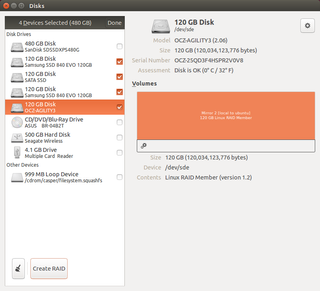
- #How to create softraid raid10 how to
- #How to create softraid raid10 install
- #How to create softraid raid10 update
- #How to create softraid raid10 software
Hardware RAID uses a RAID card to connect drives with computer.
#How to create softraid raid10 software
RAID has three types: external disk array cabinet (so called hardware RAID), internal disk array card (so called hardware-assisted RAID), and software simulation (so called software RAID). It will also utilize the multiple drives to improve the performance of the drive array, including MTBF (Mean Time Between Failure) and fault-tolerance. RAID (Redundant Arrays of Independent Drives) technology combines multiple drives into a drive array with huge capacity.
#How to create softraid raid10 how to
How to Back up Data and Manage Partition with MiniTool Partition Wizard.If drive 3 fails the data on the array is toast. It showed as a spare until the third disk finished then it started syncing.Īt step 7 I think drive 1, 2, OR 4 can fail (during resync of disk 4) without killing the array. I added the fourth disk before the third finished syncing. mdadm -v -create /dev/md1 -level=raid10 -raid-devices=4 /dev/sda missing /dev/sdb missingĬode above gives a usable array with two missing disks (add partition numbers if you aren't using whole disks).Īs soon as the third disk is added it will begin to sync. Just finished going from LVM on two 2TB disk mdadm RAID 1 to LVM on a four disk RAID 10 (two original + two new disks).Īs noted the drive order is important when creating the array. In short, create RAID10 with total 4 disks(out of which 2 are missing), resync, add other two disks after that.
#How to create softraid raid10 update
Remember to update /etc/mdadm/nf (remove md0).Īnd save config to initramfs (to be available after reboot) update-initramfs -uįollow the same procedure as Mark Turner but when you create the raid array, mention 2 missing disks mdadm -v -create /dev/md1 -level=raid10 -raid-devices=4 /dev/sda1 missing /dev/sdb2 missing mdadm -stop /dev/md0Īnd again - wait until recovery on md1 is finished. Be absolutely sure everything is working. IF IT WORKED CORRECTLY Destroy old array and add the remaining disk to the new array.Īt this point you will destroy data on the last member of the old md0 array. Some Linux rescue/boot CD works best.Ħ) Boot on new array.
#How to create softraid raid10 install
To check status use one of below commands: # status of sync/recoveryĥ) Install GRUB on the new Array (Assuming you're booting from it).

The md0 should still be usable but only if the other raid member was fully operational.Īlso note that this will begin syncing/recovery processes on md1. (this is only an example command, read the man pages for rsync) rsync -arHx / /where/ever/you/mounted/the/RAID10Ĥ) Fail 1st part of the old RAID1 (md0), and add it to the new RAID10 (md1) mdadm /dev/md0 -fail /dev/sda2 -remove /dev/sda2 rsync to copy data from old RAID 1 to the new RAID 10. The /dev/md1 should be immediately usable, but need to be formatted and then mounted.ģ) Copy files. # Save config to initramfs (to be available after reboot)Ģ) Format and mount. Mdadm -detail -scan | grep "/dev/md1" | tee -a /etc/mdadm/nf # Add new layout (grep is to make sure you don't re-add md0): Note! You should save the layout of the array: # View current mdadm config: To view layout and other details of created array use: mdadm -D /dev/md1 Your data on md1 is not safe at this point (effectively it is RAID0 until you add missing members). Note that in this example layout sda1 has a missing counterpart and sdb2 has another missing counterpart. lsblk to view your current layout.Ġ) Backup, Backup, Backup, Backup oh and BACKUPġ) Create the new array (4 devices: 2 existing, 2 missing): mdadm -v -create /dev/md1 -level=raid10 -raid-devices=4 /dev/sda1 missing /dev/sdb2 missing




 0 kommentar(er)
0 kommentar(er)
